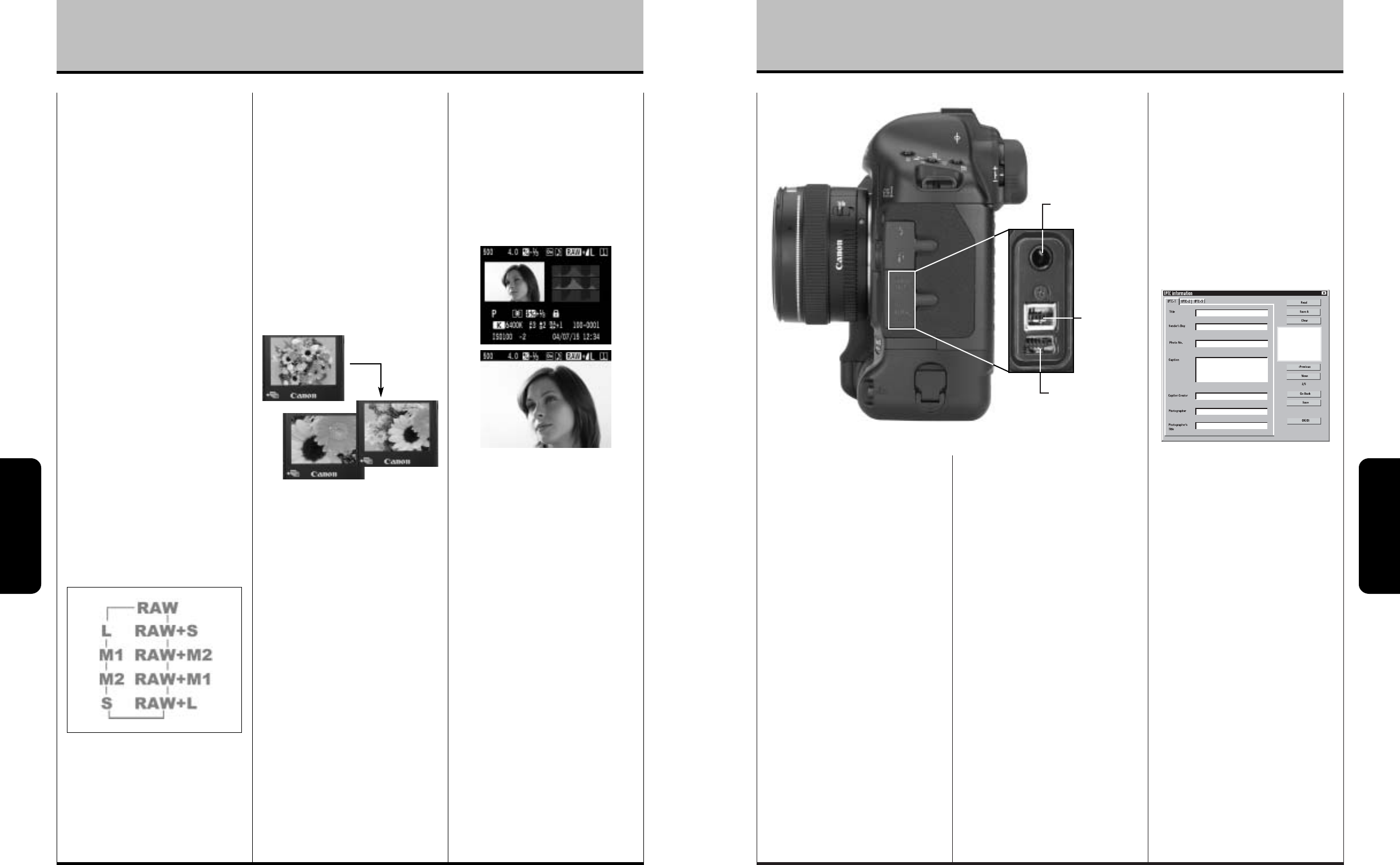
CONVENIENCE/CONNECTIVITY 15
INCREASED
CONNECTIVITY:
Faster Data Transfer Speed
The EOS-1D and -1Ds use 6-pin
FireWire
™
/IEEE1394 connections for
data transfer, the 1Ds at 60 Mbps and
the 1D at 40 Mbps. The 1D Mark II uses
a 4-pin FireWire
™
port which creates
room for a USB 1.1 interface (for Direct
Printing) and video out, all in the place
previously occupied by IEEE1394 alone.
The data transfer speed of the Mark II
is usefully faster thanks to DIGIC II:
100 Mbps. The new camera-direct USB
port, with the small Type B connector,
is used exclusively for direct printing via
Canon Card Photo Printers, Canon
Direct Photo Printers or PictBridge-
Compatible Printers. The USB and
IEEE1394 ports are positioned close
together to make it impossible for the
two to be connected at the same time.
Under the upper rubber cover, there is a
PC flash sync connection and an
N3-type remote control terminal.
VIDEO OUT:
Perfect for Display
& Demonstrations
A video out, NTSC or PAL, terminal
has been added at the request of
photographers who need to display
or demonstrate their images while
they are shooting.
NEW IPTC
COMPATIBILITY:
Perfect for Agencies &
Professional
Photographers
The photographer’s name as well as the
shooting date and time are appended
to JPEG images every time you fire the
shutter. Detailed IPTC (International
Press Telecommunication Council)
information can also be entered in the
computer via the bundled software.
In the EOS-1D and -1Ds, the IPTC data
could be appended only to RAW
images. With the Mark II, the IPTC
information can be appended to JPEG
images instead. The new Canon
software is compatible with the image
transfer software used by the news
services. This should prove to be a
substantial benefit to agencies and
photojournalists because JPEGs are
smaller and faster to transmit and
therefore far more likely to be used
in conjunction with IPTC information.
NEW EXIF 2.21
COMPATIBILITY
Adobe RGB Compatible,
Optimum Saturation Prints
Exif stands for Exchangeable Image File
Format, the worldwide standard for
storing digital images as JPEG (Joint
Photographic Experts Group) files.
It stipulates the shooting information
appended to images. The EOS-1D Mark II
supports the latest version of Exif (2.21)
which adds Adobe RGB to Exif’s color
space information. Photoshop can see
Exif 2.21 files. When an Exif 2.21
compatible application is used, it is
automatically opened using the Adobe
RGB color space. Exif 2.21 compatible
printers will produce prints with
optimum saturation adjustment.
CONVENIENCE/
CONNECTIVITY
COMPATIBILITY AND CONNECTIVITY
CONVENIENCE
IMPROVED EASE OF
OPERATION:
Improved Access to
Common Functions
In response to users who had trouble
operating the 1D memory card slot
cover knob with their gloves on, the
shape of the knob handle has been
changed and a recess has been created
under the handle. The door has also
been modified to prevent data loss
in case the slot cover is opened
accidentally during data writing.
The data writing resumes when
the slot cover is closed.
Some commonly used functions have
been made more accessible. JPEG, RAW
and RAW + JPEG can be selected in a
single operation and the color
temperature can be set directly with
the WB button and the main dial
without using the menu. Frequently-
used ISO speed extensions have been
moved to the menu screen from the
Custom Functions. An Enlarge button
has been added to control screen
magnifications. The Erase button has
been moved to the bottom row with the
Recording Quality and White Balance
buttons. The Erase button also has a
small raised point in its center to
distinguish it from the other buttons.
Even when reviewing work or adjusting
settings, pressing the shutter button
will return the camera to shooting mode
instantly so you’ll never miss something
important while you’re fiddling with
buttons and dials.
EXTENDED PLAYBACK
CAPABILITIES:
Image Rotation and Zoom
Features/ RGB Histogram
Option
Automatic/ Manual Image Rotation and
zoom features have been incorporated
into the EOS-1D Mark II’s image playback
options. Maximum magnification is up
to 10x in 15 steps, accessed by holding
down the magnify and the plus or
minus buttons. It is also possible to
scroll around the image while it is
magnified and to view the next image
while retaining the magnification setting.
Another significant new playback option
is the RGB Histogram option, enabling
the user to check white balance bias,
color balance, color saturation, color
gradation compression, as well as other
color-related information that the
brightness display does not show.
FOLDER MANAGEMENT:
Create Up To 500 Folders
Images on the memory cards are stored
in master “DCIM” folders. Within these
folders, you can create up to 500
additional folders and assign images
to any folder with the ability to add
new folders or change to a previous
folder at any time. You can protect or
delete images on a folder-by-folder
basis. All this is done within the
camera using the menu controls.
HIGH RESOLUTION LCD
SCREEN:
Sharp and Detailed
The new 2-inch, polysilicon TFT LCD
screen has 230,000 pixels, nearly
double the 120,000 of the 1D/1Ds.
The display is very sharp and detailed
so it is easier to read text and data
and to evaluate images.
CAMERA SETTING
RETENTION:
Store Your Personal
Settings
Almost all the camera settings
displayed on the top and rear LCD
panels and in the menus can be saved
to a memory card. Benefits that attend
to this advance include:
• Personal settings or settings for a
specific stadium can be shared with
and used on multiple cameras.
• The menu and C.Fn/P.Fn settings
specified on one camera can be saved
and uploaded to another camera,
speeding up and simplifying complex
setup tasks and minimizing the
chance that errors might occur.
• When the camera is sent in for servicing
or repairs, personal settings can be
stored and then reloaded when the
camera is returned so that the camera
is set up exactly as before.
14 CONVENIENCE/CONNECTIVITY
CONVENIENCE/
CONNECTIVITY
Video OUT termina
l
Digital port
(IEEE 1394)
Camera direct port
(USB)














